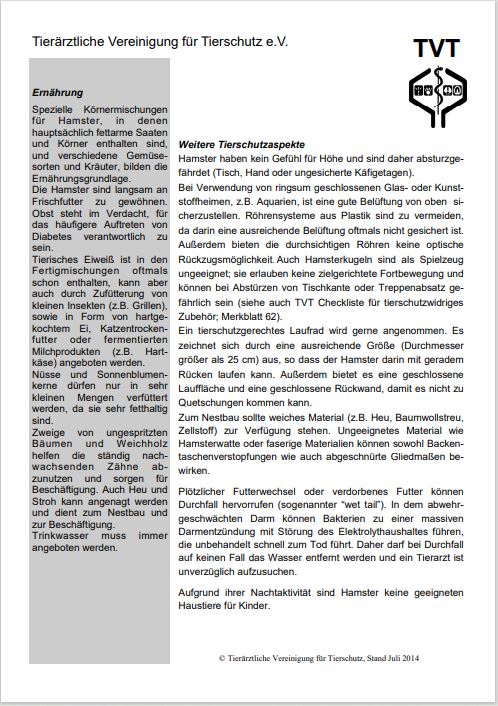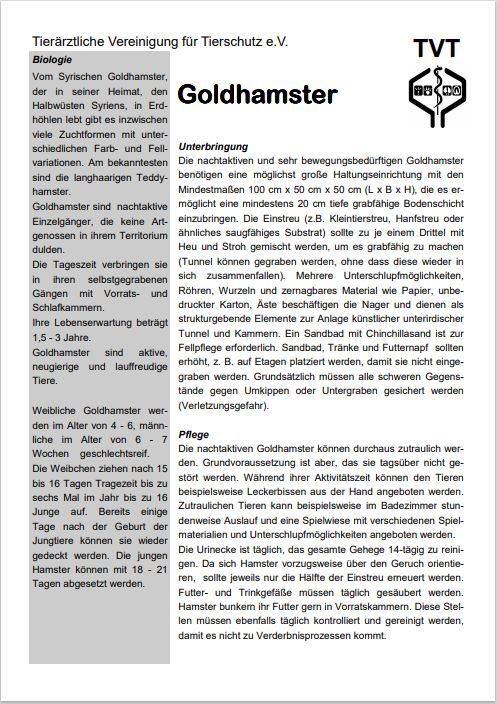TVT Care Sheet
We are providing a translated version of The TVT Hamster Care Sheet from Tierärztliche Vereinigung für Tierschutz (The Veterinary Association for Animal Welfare). A translated version of The TVT website can be seen here. PDF Taken from this page TVT Publications for download.
- Germany offers some of the highest animal welfare standards for hamsters in the world It is said that “Since 2014, it’s required by law that pet shops inform customers about the minimum cage size requirement of 100 x 50 cm.
- The Veterinarian Association for Animal Welfare views 100 x 50 cm as the absolute minimum cage size, as can be seen in the TVT Hamster Care Sheet translated to English below:
Accommodation
The nocturnal golden hamster needs to be very active and needs the largest possible housing facility with the Minimum dimensions 100 cm x 50 cm x 50 cm (L x W x H), which allows for a soil layer that can be digged at least 20 cm deep. The litter (e.g. small animal litter, hemp litter or similar absorbent substrate) should also contain a third hay and straw, mixed together for digging (Tunnels can be dug without them collapsing back in). Several hiding places, Tubes, roots and gnawable material such as paper, unprinted cardboard and branches occupy the rodents and serve as structural elements for the creation of artificial underground tunnels and chambers. A sand bath with chinchilla sand is required for grooming. Sand bath, drinking trough and food bowl should be raised, e.g. be placed on floors so that they are not buried. In principle, all heavy objects must be secured against tipping over or being undermined (Risk of injury).
Maintenance
The nocturnal golden hamster can become trusting. The basic requirement is that they are not disturbed during the day. During their activity time the animals can for example accept hand-held delicacies when offered. Trusting animals can, for example, be offered an hourly run in the bathroom and a playground with various play materials and shelter options. The urine corner is to be cleaned daily and the entire enclosure every 14 days. Since hamsters prefer to use the smell to orient themselves, only half of the litter should be renewed at a time. Feeding and drinking vessels must be cleaned daily. Hamsters like to store their food in pantries. These areas must also be checked and cleaned daily, so that there is no contamination.
Biology
The Syrian golden hamsters homeland is the Semi-deserts of Syria, there are some who have adapted to living in caves many breeding forms with different colour and coat variations. Best known are the long-haired teddy hamsters. Syrian hamsters are nocturnal Loners who tolerate no members of the same species in their territory. They spend the time of day in their self-dug aisles with supply and sleeping chambers. Your life expectancy is 1.5 – 3 years. Golden hamsters are active, curious and happy to run animals. Female golden hamsters are aged 4 – 6 weeks, males aged 6 – 7 weeks until sexually mature. The females have a gestation period of 15 to 16 days, six times a year up to 16 Boy up. Already a few days after the birth young animals can do it again. The young hamsters can be aged between 18 and 21 days until they are dismissed.
 Other Animal Welfare Aspects
Other Animal Welfare Aspects
Hamsters have no sense of height and are therefore at risk of falling (table, hand or unsecured cage floors). When using all-round closed glass or plastic houses, e.g. aquariums, good ventilation from above must be ensured. Plastic tube systems are to be avoided as sufficient ventilation is often not ensured in them. In addition, the transparent tubes offer no optical possibility of retreat. Hamster balls are also not suitable; they do not allow targeted locomotion and can be dangerous if you fall from the edge of a table or landing (see also TVT checklist for animal welfare issues Equipment; Leaflet 62).
An animal welfare-friendly wheel is gladly accepted. It is characterized by a sufficient size (diameter larger than 25 cm) so that the hamster can run in it with a straight back. It should also have closed tread and a closed back wall so that bruises don’t occur.
Unsuitable soft material like hamster cotton or fibrous materials can cause cheek pouch blockages as well as constricted limbs.
Sudden change of food or spoiled food can Cause diarrhoea (so-called “wet tail”). In an immune-weakened intestine, bacteria can become vast causing intestinal inflammation with disturbance of the electrolyte balance, which, if left untreated, can quickly lead to death. Therefore, if you have diarrhoea in no case should the water be removed and visit a veterinarian immediately.
Because of their nocturnal activity, hamsters are not suitable pets for children.
Nutrition
Special grain mixes for hamsters in which mainly low-fat seeds and grains are included, and various vegetables and herbs, make up the nutritional basis. The hamster can gradually get used to fresh food. Fruit is suspected to be responsible for the more frequent occurrence of diabetes. Animal protein is often already included in the ready mixes, but can also be given by feeding small insects (e.g. crickets), as well as in the form of hard-boiled egg, dry cat food or fermented dairy products (e.g. hard cheese) can be offered. Nuts and sunflower seeds are only allowed in small quantities because they are very fatty. Branches of unsprayed trees and softwood help to wear out the constantly growing teeth and take care of them. Also hay and straw can be gnawed and is used for nest building. Drinking water must always be offered.

 Other Animal Welfare Aspects
Other Animal Welfare Aspects